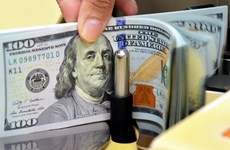Hanoi affirms status as nation’s economic locomotive
 Hanoi is striving to fulfill its economic goals for the fourth quarter of the year and the entire 2021, which would lay as a basis for growth in 2022 and the following years. (Photo: VNA)
Hanoi is striving to fulfill its economic goals for the fourth quarter of the year and the entire 2021, which would lay as a basis for growth in 2022 and the following years. (Photo: VNA)Hanoi (VNA) – Sixty-seven years ago, the capital city of Hanoi was liberated from the French colonial rule on October 10. So this month has a special meaning to the Hanoians and is always a time for the city to look back at what it has done in the past and embrace the future.
Liberation has marked a new chapter for the city’s development era as a locomotive of the national economy.
During the anti-US war, Hanoi became the economic pillar of the north, providing food supplies and reinforcements to the southern battle fields. After the country gained independence in 1975, the city continued to be a hub for economic reconstruction and development as well as social and cultural affairs. It has seen robust economic growth since then, with significant improvement of people’s living standards.
From 2015 – 2020, the economy of Hanoi expanded 7.23 percent in average annually, contributing 16.46 percent of the national Gross Domestic Products (GDP) and 19.05 percent of the State budget revenue, though the city accounts for just 1 percent of the country’s total area and 8.1 percent of the population.
Like many other parts of the country, Hanoi has suffered greatly over the last two years because of the COVID-19 pandemic. The fourth coronavirus wave, which started in late April, has been wreaking havoc on the city’s economy, with a number of sectors, particularly transport, trade, services, and hospitality struggling. Hanoi’s Gross Regional Domestic Products (GRDP) in the third quarter of 2021 declined 7.02 percent against a year earlier. The nine-month GRDP slightly edged up 1.28 percent against the same period last year.
Thanks to the city’s relentless efforts to tackle difficulties and maintain supply chains, Hanoi has managed to record encouraging economic performance. The State budget revenue exceeded 176.7 trillion VND (nearly 7.7 billion USD) in the first three quarter of this year, up 5.4 percent year on year. Its exports reached over 1.29 billion USD in September, up 1.5 percent month on month and 2.8 percent year on year.
The agriculture, forestry, and fisheries sector expanded 3 percent year on year from January – September and the services sector rose by 0.85 percent year on year. The Consumer Price Index (CPI) was kept under good control, picking up 1.54 percent during the period.
Entering October, Hanoi has made a comeback after two months of social distancing order to contain the spread of COVID-19, with a new strategy of flexibly and safely living with the virus and gradually reopening in order to revive the economy.
The city is striving to fulfill its economic goals for the fourth quarter of the year and the entire 2021, which would lay as a basis for growth in 2022 and the following years.
From the start of October, all sectors and all-level administrations must begin building recovery and development plans, urged Chairman of the municipal People’s Committee Chu Ngoc Anh. He also highlighted the need to build a set of standards for safe resumption of business and production in the context of COVID-19, come up with measures and mechanisms to support local enterprises, and organise dialogues to listen to the business community about their challenges.
Despite various difficulties induced by the pandemic, Hanoi is turning eye towards the future. It has adopted plans for local socio-economic development and mid-term public investment over the next five years, in which the city developed two scenarios for economic growth given the uncertainties caused by the COVID-19.
Accordingly, its GRDP growth is expected to range between 6.5 – 7.5 percent annually from 2021 – 2025. The city also aims to rapidly evolve into an industrialised and modernised city and the main driver of the Northern Key Economic Region./.













